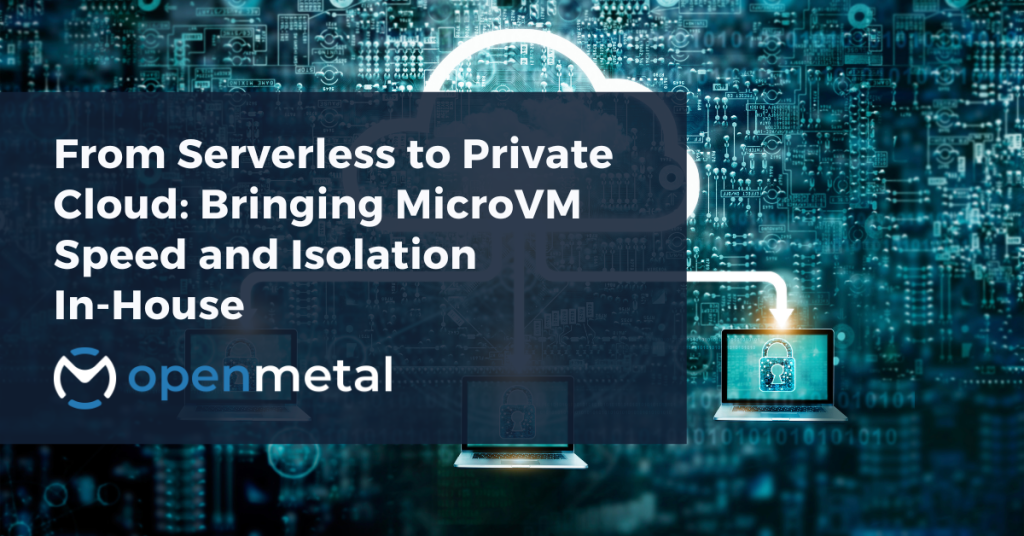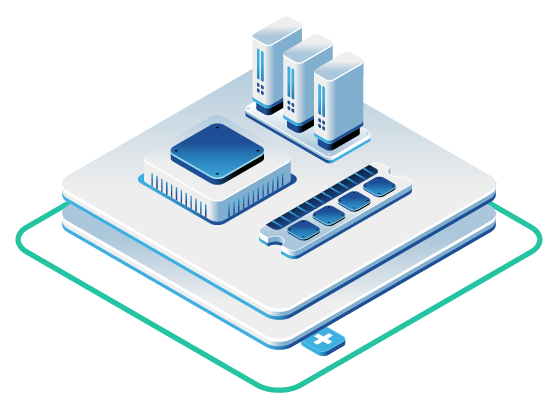
Want to leverage OpenMetal for your MicroVM SaaS?
The OpenMetal team is standing by to assist you with scoping out a fixed-cost model based infrastructure plan to fit your needs, budgets and timelines.
The serverless revolution promised to liberate developers from infrastructure management, enabling them to focus purely on business logic while cloud providers handled scaling, provisioning, and operations. For many organizations, serverless computing delivered on this promise—at least initially. However, as workloads grew and requirements evolved, the limitations became apparent: vendor lock-in, unpredictable costs, execution limits, and lack of control over the underlying infrastructure.
The technology that makes serverless possible—microVMs—offers a path forward. By bringing microVM-based architectures in-house through private cloud infrastructure, you can capture the benefits of serverless computing while maintaining control, predictability, and performance that public cloud services cannot guarantee.
The MicroVM Revolution: The Engine Behind Serverless
MicroVMs represent a fundamental shift in virtualization technology. Unlike traditional virtual machines that carry the overhead of full guest operating systems, microVMs are lightweight, purpose-built environments that start in milliseconds and consume minimal resources. Technologies like AWS Firecracker, Intel’s Cloud Hypervisor, and Kata Containers have made it possible to achieve near-container performance with VM-level isolation (AWS, 2024).
AWS Firecracker, originally developed for Lambda and Fargate, demonstrates the potential of microVMs in production. It can launch thousands of microVMs on a single host while maintaining strong security boundaries—each microVM gets its own kernel and memory space, eliminating the shared-kernel vulnerabilities that affect traditional containers (AWS, 2024).
Cloud Hypervisor, championed by companies like Cloudflare, takes a different approach by focusing on modern cloud workloads and offering GPU passthrough capabilities for AI and machine learning applications (Cloudflare, 2024). Meanwhile, Kata Containers provides seamless integration with Kubernetes, allowing you to run containers within microVMs without changing your existing orchestration workflows (Kata Containers, 2024).
The key advantage of microVMs lies in their ability to provide strong isolation without the performance penalty of traditional virtualization. They boot faster than containers in many cases, use less memory than full VMs, and offer the security properties that enterprise applications demand.
Case Study: SaaS Video Processing Platform Migration
Consider a hypothetical SaaS video processing company that initially built their platform on AWS Lambda. The serverless approach worked well for their MVP—customers could upload videos, Lambda functions would process them through various filters and transformations, and the results would be stored in S3. The company enjoyed automatic scaling and pay-per-execution billing.
However, as they grew to processing thousands of hours of video daily, several challenges emerged:
- Cost unpredictability: Lambda’s per-request pricing meant monthly bills fluctuated wildly based on customer usage patterns
- Execution limits: Lambda’s 15-minute maximum execution time forced them to split large video files into smaller chunks, adding complexity
- Cold starts: Despite AWS optimizations, cold starts still added 2-3 seconds to processing time, impacting user experience
- Vendor lock-in: Their code became tightly coupled to AWS APIs and Lambda’s specific runtime environment
The company decided to migrate to a private cloud architecture using OpenMetal’s hosted infrastructure. By implementing their own microVM-based processing system, they achieved:
- Predictable costs: Flat-rate infrastructure pricing eliminated billing surprises
- No execution limits: Video processing could run as long as needed
- Consistent performance: Dedicated hardware eliminated the variable performance of shared public cloud resources
- Technology choice: Freedom to use any microVM technology and customize the runtime environment
The migration took three months, but the results were immediate: 40% reduction in infrastructure costs, 60% improvement in processing consistency, and the ability to offer SLA guarantees to enterprise customers.
Building Your In-House Serverless Platform: A Technical Implementation Guide
Creating a production-ready microVM-based serverless platform requires several key components working in concert. Here’s how to implement each layer:
API Gateway and Request Handling
Your serverless platform needs a robust API gateway to handle incoming requests, route them to appropriate functions, and manage authentication. Popular open-source options include Kong, Envoy Proxy, or Traefik. The gateway should:
- Handle SSL termination and certificate management
- Implement rate limiting and authentication
- Route requests based on function definitions
- Collect metrics and logs for monitoring
Orchestration Layer
The orchestration layer manages the lifecycle of your functions and microVMs. You have several options:
OpenFaaS: Provides a Docker-like experience for serverless functions and integrates well with Kubernetes (OpenFaaS, 2024)
Knative: Offers sophisticated auto-scaling and blue-green deployments on Kubernetes (Knative, 2024)
Custom Solution: Build your own orchestrator using OpenStack’s Nova API for microVM management
MicroVM Integration
Choose your microVM technology based on your specific requirements:
- Firecracker: Best for high-density workloads with minimal resource overhead
- Cloud Hypervisor: Ideal for GPU-accelerated workloads and modern cloud applications
- Kata Containers: Perfect if you want seamless Kubernetes integration
Your orchestration layer should integrate with OpenStack’s Nova compute service to launch microVMs on demand, passing function code and configuration as user data or through attached volumes.
Event Queue System
Implement an event-driven architecture using message queues like RabbitMQ, Apache Kafka, or Redis Streams. This allows functions to be triggered by various events:
- HTTP requests via the API gateway
- File uploads to object storage
- Database changes
- Scheduled events (cron-like functionality)
- Custom application events
Auto-Scaling with OpenMetal Infrastructure
OpenMetal’s API-driven infrastructure enables sophisticated auto-scaling strategies:
Horizontal Pod Scaling: Scale the number of microVMs handling requests based on queue depth or CPU utilization
Cluster Scaling: Use OpenMetal’s API to add compute nodes when resource utilization exceeds thresholds
Predictive Scaling: Analyze historical usage patterns to pre-scale infrastructure during anticipated peak periods
Geographic Scaling: Deploy additional OpenMetal clusters in different regions for global applications
Storage Integration
Leverage OpenMetal’s integrated Ceph storage for your serverless platform:
- Function artifacts: Store function code and dependencies in Ceph object storage (Swift)
- Temporary data: Use Ceph block storage (Cinder) for functions that need persistent disk space
- Shared data: Implement shared file systems using CephFS for functions that need to share state
Networking and Security
OpenMetal’s software-defined networking capabilities enable sophisticated security models:
- Network isolation: Use OpenStack’s Neutron to create isolated networks for different tenants or applications
- Security groups: Implement fine-grained firewall rules for microVM communication
- VPN connectivity: Connect your serverless platform securely to on-premises systems
Load balancing: Distribute traffic across multiple microVM instances
Why OpenMetal Provides the Ideal Foundation
If microVMs are the engine of in-house serverless, then the private cloud is the chassis, transmission, and wheels. To get the speed, control, and elasticity that microVM architectures demand, organizations need more than just bare metal servers—they need a full-featured cloud environment. This is where OpenMetal’s Hosted Private Cloud offering stands apart.
On-Demand Infrastructure Without the Wait
Traditional private cloud deployments take weeks or months to provision and configure. OpenMetal delivers a fully functional OpenStack cloud on dedicated hardware in minutes. You get immediate access to compute, storage, and networking APIs, allowing you to start building your serverless platform immediately rather than waiting for infrastructure procurement and setup.
Predictable Performance for Consistent User Experience
Public cloud’s shared infrastructure means your microVMs compete with other tenants for resources, leading to variable performance. OpenMetal’s dedicated hardware ensures your microVMs get consistent CPU, memory, and I/O performance. This predictability is critical for serverless platforms where users expect consistent response times.
Integrated Storage Architecture
OpenMetal’s integration of Ceph storage with OpenStack provides everything your serverless platform needs. Object storage handles function artifacts and results, block storage provides persistent volumes for stateful functions, and the unified management reduces operational complexity compared to cobbling together separate storage solutions.
Elastic Scaling Within Predictable Economics
Unlike public cloud’s per-resource pricing that can lead to bill shock, OpenMetal’s flat-rate infrastructure pricing lets you scale aggressively without fear of runaway costs. Your finance team can budget accurately, and you can offer your internal customers unlimited usage within reasonable bounds.
Enterprise-Grade Security and Compliance
OpenMetal operates in Tier III data centers with SOC2 and ISO certifications, providing the foundation for compliance with industry regulations. HIPAA-compliant environments are available for healthcare applications. You maintain full control over data location and access, something impossible with public serverless platforms.
Freedom from Vendor Lock-In
Public FaaS platforms lock you into proprietary APIs, runtime environments, and execution models. OpenMetal enables you to use open-source technologies like Firecracker, Cloud Hypervisor, or Kata Containers directly. You can customize kernels, modify runtime environments, and integrate with any orchestration system without vendor restrictions.
Access to Cutting-Edge Innovation
The microVM ecosystem evolves rapidly, with new features like GPU passthrough, vhost-user networking, and enhanced security models. OpenMetal’s foundation on open technologies means you can adopt these innovations as they become available, rather than waiting for a vendor to decide what features to support.
API-First Architecture for Automation
OpenMetal provides comprehensive APIs for infrastructure management, enabling you to build sophisticated automation around your serverless platform. Automatically scale clusters, provision new environments, and integrate with your CI/CD pipelines without manual intervention.
In summary: OpenMetal is not just another hosting provider—it’s a launchpad for next-generation architectures. For teams looking to bring the agility of serverless in-house, OpenMetal provides the right blend of automation, integration, control, and cost efficiency. With dedicated hardware, API-driven elasticity, and built-in OpenStack + Ceph, it offers the perfect foundation for microVM-powered platforms that rival AWS Lambda—without the trade-offs.
The Future of In-House Serverless
The convergence of microVM technology and modern private cloud infrastructure creates unprecedented opportunities for organizations seeking serverless benefits without public cloud compromises. As microVM technologies mature and gain features like improved networking, GPU support, and enhanced security models, the gap between public and private serverless implementations will continue to narrow.
OpenMetal represents the best of both worlds: the agility and elasticity of public cloud with the control and predictability of private infrastructure. By building your serverless platform on OpenMetal’s foundation, you gain the freedom to innovate without constraints while maintaining the performance and economic predictability your business demands.
The question isn’t whether you should move beyond public serverless—it’s how quickly you can implement a solution that gives you back control over your infrastructure destiny. With microVMs and OpenMetal, that future is available today.
Want to learn more about running MicroVMs on OpenMetal’s private infrastruture?
Explore how OpenMetal can help with a PoC Cloud
Start with a risk-free evaluation: Take advantage of OpenMetal’s Proof of Concept program to validate how hosted private cloud can transform your delivery model.
Works Cited
- AWS. “Firecracker MicroVMs.” AWS Open Source, 2024, https://aws.amazon.com/firecracker/.
- Cloudflare. “Cloud Hypervisor and the Future of Lightweight Virtualization.” Cloudflare Blog, 2024, https://blog.cloudflare.com/cloud-hypervisor/.
- Kata Containers. “Kata Containers Documentation.” Kata Containers, 2024, https://katacontainers.io/.
- Knative. “Knative: Kubernetes-based Platform to Deploy and Manage Serverless Workloads.” Knative, 2024, https://knative.dev/.
- OpenFaaS. “Serverless Functions Made Simple.” OpenFaaS, 2024, https://www.openfaas.com/.
- OpenStack Foundation. “OpenStack and Kata Integration.” Open Infrastructure Foundation, 2024, https://www.openstack.org/.


































